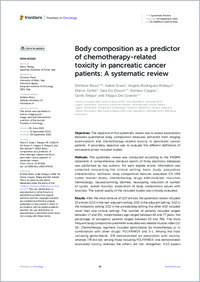Body composition as a predictor of chemotherapy-related toxicity in pancreatic cancer patients : a systematic review
- Rizzo, Stefania Istituto di Imaging della Svizzera Italiana (IIMSI), Ente Ospedaliero Cantonale (EOC), Lugano, Switzerland - Faculty of Biomedical Sciences, Università della Svizzera italiana, Switzerland
- Scala, Isabel Faculty of Biomedical Sciences, Università della Svizzera italiana, Switzerland
- Rodriguez Robayo, Angela Department of Radiology, Fundación Villavicencio, Rosario, Argentina
- Cefalì, Marco Istituto Oncologico della Svizzera Italiana (IOSI), Ente Ospedaliero Cantonale (EOC), Bellinzona, Switzerland
- De Dosso, Sara Faculty of Biomedical Sciences, Università della Svizzera italiana, Switzerland - Istituto Oncologico della Svizzera Italiana (IOSI), Ente Ospedaliero Cantonale (EOC), Bellinzona, Switzerland
- Cappio, Stefano Istituto di Imaging della Svizzera Italiana (IIMSI), Ente Ospedaliero Cantonale (EOC), Lugano, Switzerland
- Xhepa, Genti Istituto di Imaging della Svizzera Italiana (IIMSI), Ente Ospedaliero Cantonale (EOC), Lugano, Switzerland
- Del Grande, Filippo Istituto di Imaging della Svizzera Italiana (IIMSI), Ente Ospedaliero Cantonale (EOC), Lugano, Switzerland - Faculty of Biomedical Sciences, Università della Svizzera italiana, Switzerland
- 2022
Published in:
- Frontiers in oncology. - 2022, vol. 12
English
Objectives: the objective of this systematic review was to assess associations between quantitative body composition measures extracted from imaging examinations and chemotherapy-related toxicity in pancreatic cancer patients. A secondary objective was to evaluate the different definitions of sarcopenia across included studies. Methods: this systematic review was conducted according to the PRISMA statement. A comprehensive literature search of three electronic databases was performed by two authors. For each eligible article, information was collected concerning the clinical setting; basic study; population characteristics; technical; body composition features evaluated; CA 19.9 tumor marker levels; chemotherapy drugs administered; toxicities (hematologic, nausea/vomiting, diarrhea, neuropathy, reduction of number of cycles, overall toxicity); association of body composition values with toxicities. The overall quality of the included studies was critically evaluated. Results: after the initial retrieval of 1137 articles, the systematic review included 12 articles (1/12 in the neo-adjuvant setting; 2/12 in the adjuvant setting; 3/12 in the metastatic setting; 2/12 in the unresectable setting; the other 4/12 included more than one clinical setting). The number of patients included ranged between 17 and 251; mean/median age ranged between 63 and 77 years; the percentage of sarcopenic patients ranged between 23 and 76%. The most frequent body composition parameter evaluated was skeletal muscle index (11/12). Chemotherapy regimens included gemcitabine (as monotherapy or in combination with other drugs); FOLFIRINOX and S-1. Among the trials including gemcitabine, 2/9 demonstrated an association with toxicity, whereas 7/9 did not; among those including FOLFIRINOX, one demonstrated associated toxicity whereas the others did not. Altogether, 4/12 papers demonstrated an association between the body composition values and the development of chemotherapy-related toxicities. Conclusions: there is a wide variability of results about the association of body composition and chemotherapy-related toxicity in PC patients. Furthermore, cut-off values to define sarcopenia in PC patients are not yet uniformly defined.
- Collections
- Language
-
- English
- Classification
- Medicine
- License
- Open access status
- gold
- Identifiers
-
- DOI 10.3389/fonc.2022.974116
- ARK ark:/12658/srd1331389
- Persistent URL
- https://n2t.net/ark:/12658/srd1331389
Statistics
Document views: 41
File downloads:
- Rizzo_2022_Frontiers_Oncology_Body composition as a predictor: 50
